The mattress is the main part of the bed, which allows the body to take the correct position while sleeping. In this article we will talk about modern mattresses, their types and materials, and describe the main factors that you need to keep in mind when choosing a mattress.
Which mattress is orthopedic?
First, we will focus on the term “orthopedic mattress”.
The word orthopedics comes from the Greek. ortos - straight, correct and pedia - education. This is the name of the branch of medicine that includes the study, treatment and prevention of persistent curvatures, deformities of the spine and limbs.
“Orthopedic” means “intended for the treatment of any deformities of the body and their compensation.”
The term “orthopedic” was attached to mattresses by the manufacturers themselves, and it has little to do with the matter. A mattress will never cure anyone. This must be understood very clearly, and one should not expect miracles from an orthopedic mattress, such as healing osteochondrosis or scoliosis. However, a properly selected mattress can relieve pain caused by incorrect spinal position. You will get better sleep and toss and turn less. This means you will feel better during the day.
An orthopedic mattress has the right to be called one that allows the spine of a particular person to remain straight during the entire time of lying down. This means that not a single mattress in itself can be called orthopedic.
The property of orthopedicity, i.e. correct location the user’s body is characteristic not of a specific mattress, but of the “person” + “mattress” complex.
Imagine a plump person lying on a soft mattress. The mattress will sag in the middle, the person will feel the “hammock effect” - the lower back is at the bottom, the legs and head are at the top. Inconvenient.
And a thin girl lying on an overly hard mattress will again lie incorrectly. The mattress will not sag, the spine will be in a curved position, which will cause discomfort and pain in the joints.
Therefore, it is necessary to correlate your physical data and the properties of the mattress. Only a mattress that is correctly selected individually for you can be called orthopedic.
Now let's focus on technologies and materials.
Mattresses come in spring and springless types. However, it cannot be said that spring ones are better than springless ones, or vice versa. These are two directions that exist together, and both have their advantages and disadvantages. The choice of mattress type is very individual and subjective. There are also water mattresses (filled with water) and air mattresses (inflatable). The operation of water mattresses is quite problematic, and in our country these mattresses are not particularly popular. Inflatable ones are only suitable as a temporary sleeping place for guests.
A spring mattress consists of a spring block itself, and layers that separate the user’s body from the springs.
Spring blocks are divided into dependent and independent.
The dependent ones are called “bonnel”; this is the filling of almost all old mattresses and modern economy class mattresses. All the springs are connected to each other by metal wire, if you press one spring hard, the neighboring ones will also be pressed. The properties of such mattresses leave much to be desired, but for the price they are a normal option. Of course, such a mattress does not apply to the title of “orthopedic”. Just a mattress, that's all.
Independent springs are a completely different matter. Each spring is in a separate case. The covers are connected into a “machine gun belt”, and the tapes are glued together. This results in a block of independent springs. Pressing one spring does not press down the neighboring ones, which means that the mattress will provide good support for problem areas such as the lower back. If two people sleep on such a mattress, they will not roll towards each other.
Independent springs are by far the best and most “correct” basis for spring mattresses.
Independent springs differ in the diameter of the spring, and therefore in the number of springs per square meter of the spring block. The standard value is 220-260 springs per sq.m. "Multipocket" blocks contain up to 1000 springs per sq.m. They contour to the body more accurately, have excellent orthopedic properties, support more weight, and often feel stiffer. Perhaps their only drawback is their rather high cost.
When choosing a mattress, find out what maximum weight (per person) the spring block is designed for. This is a key parameter.
Layers are placed on top of the springs, which impart surface rigidity or softness. The most popular fillers are:
Polyurethane foam, artificial latex, foam rubber - soft filler. Artificial. Relatively inexpensive, popular in economical models.
Natural latex is an even softer, more elastic filler and more comfortable. It has elastic, “rubbery” properties, because is foamed rubber. Made from the sap of the Hevea tree. Natural is very relative - usually 20-60%.
Material with memory effect, memoryform (and a dozen other names) are soft, viscous materials of a new generation. They react to pressure and heat and for a second or two “remember” the shape of the body, such a “plasticine” effect. They improve the comfort of the mattress and have an anti-decubitus effect. Many people like such materials, but not everyone. Therefore, before buying such a mattress, it is better to try to lie on it to make sure whether it is comfortable for you.
Coconut (coconut coir) is a hard natural filler. Usually coir is impregnated with latex. Coir is less durable than, for example, foam rubber or latex. Not recommended for people with heavy weight, because... may start to crumble.
Felt. It is used as a cushioning material between layers, and simply as a soft layer in a mattress. In the latter case, its main characteristic is fragility.
The most popular types of spring mattresses:
- Independent springs + 3 cm of natural latex - soft mattress.
- Independent springs + 3 cm coconut - surface-hard mattress.
- Independent springs + 1 cm of coconut + 3 cm of latex - a mattress of medium hardness.
Demon spring mattresses are made either from a monoblock of one material, or from layers of different materials. Let us describe the properties of the main types of springless mattresses:
Most popular group- mattresses made of artificial latex, waterlatex, foam rubber, bilaxilast, etc. Hard, recommended for people with problems in the upper spine, as well as for children and adolescents. A good alternative to "bonnel". Such models of Italian and Russian production can be attributed to the “affordable” price segment. Almost always supplied in roll form, "vacuum" packaging. This mattress is easy to transport; it will fit into a car, but if you open it, you won’t be able to roll it back up.
Mattresses made from natural latex are mostly soft, often multi-zone - different hardness for different parts of the body. By the way, multi-zones are also found in spring mattresses.
Mattresses made from Coconut-Latex combinations are usually hard or very hard. Orthopedic properties are not the best.
Mattresses made from coconut monolith are extremely hard. The feeling is almost like being on boards covered with a blanket.
Tips for choosing a mattress.
Talk that the hardest mattress is the most beneficial for the spine is nothing more than a misconception. The most important thing in a mattress is that you are comfortable. Not “seemingly convenient”, but “convenient”. The mattress should not be too soft or too hard. The concept of convenience is largely subjective, so rely not only on general advice, but also on your personal preferences.
Economical mattresses based on a Bonnell spring block can hardly be called orthopedic. But nevertheless, a new mattress, even one based on Bonnell, will be much better than a sagging old one. The only alternative in the “Bonnel” price segment is Russian-made springless mattresses (based on artificial latex, or foam rubber). The properties of such mattresses are significantly better than those of Bonnelles.
For people of average build, most models will suit independent springs ah, in particular, models that use latex layers and coir-latex combinations. It is generally accepted that spring mattresses are more comfortable than springless ones.
Overweight people should take a closer look at stiffer mattresses: spring mattresses with reinforced springs, "Multipocket" blocks, springless ones made of dense materials.
Thin people are better off choosing soft models without using coir.
- Springless mattresses are usually recommended for children and teenagers.
- Very young children do not care what they sleep on; it is important that the mattress is well ventilated. As a rule, they buy a coconut mattress (mattress cover) 3-7 cm thick.
- For older children, it is already important that the mattress is durable enough to withstand jumping on it, etc., so coconut is not the best option.
- For teenagers, springless, artificial latex, hard mattresses are recommended.
- If you have lower back pain, a hard mattress is contraindicated; you need to choose from soft, well-flexible models that support the lower back.
- People with problems in the upper parts of the spine on the contrary, it is worth taking a closer look at hard mattresses.
- Hard and semi-rigid mattresses are often recommended by orthopedic doctors to their patients suffering from spinal diseases. You should listen to your doctor's advice, however, if you are healthy, then sleeping on a board covered with a blanket is not only not healthy, but can also harm your joints.
So, let us emphasize once again: a mattress cannot be orthopedic in general, it can be orthopedic for you.
When it comes to selecting a mattress, it is best to contact a specialized store; it is there that the buyer will be asked about the weight, height and age of the sleepers, about existing spinal diseases, and about their wishes for rigidity. Selecting a mattress is not only banal advice about what is better and worse, it is also a balance between the optimal characteristics of the mattress and the limited purchase budget.
A mattress, like any thing, does not last forever, and it is recommended to replace any, even the most expensive, mattress with a new one after 8-12 years. For economy class mattresses, the lifespan is even shorter: 3-5 years.
To get a good night's rest, you need to go to bed on a comfortable bed. First of all, there should be a good mattress on it. Customer reviews indicate that this is not easy to do. The product does not belong to the category of frequently purchased products, so a mistake in selection can be costly.
What are the dangers of choosing the wrong mattress?
In addition to morning stiffness and insomnia, owners of an incorrectly selected mattress can expect chronic diseases such as arthritis, osteochondrosis, and asthma.
Sometimes people suffering from spinal diseases lie down without a mattress at all. But in that case long time the body is curved to one side. This is harmful and inconvenient. A universal mattress should first and foremost be comfortable.
Manufacturers call their products anatomical, or orthopedic, therapeutic. They indicate that they bend according to the curves of the human body. But the same product is not anatomical for people of different weights and heights. And it should be anatomical only for you.
Functions performed by the mattress
What are the requirements for this desired product?
- The mattress should support your back strictly horizontally during sleep. The base is responsible for this function. It can be spring blocks or latex.
- The comfort of sleep provided by the filling and covering.
What mattress to look for
This largely depends on the person's weight. If you are not overweight, soft and medium-soft mattresses are suitable for you. If you can be considered overweight, then hard or medium-hard is more suitable. If you are looking for a children's mattress, reviews advise buying a firmer model.
When shopping for a mattress, carefully measure your bed. The mattress should not be wider than it. The optimal width would be a couple of centimeters less.

Look for a mattress with jacquard upholstery. The cover must have a synthetic padding lining. You can buy a mattress with a cover with a zipper. But customer reviews say that they quickly lose their shape.
If you don't find a suitable one, you can order it.
Mattresses without springs
All mattresses without springs are divided into hard, medium-hard and medium-soft. They usually consist of several layers. The characteristics of each of them determine the quality of the entire product.
Non-spring mattresses can be made from solid latex that is vacuum sealed. Latex can be natural or artificial.
Reviews of mattresses indicate that latex mattresses are softer than polyurethane foam ones, although both types are quite comfortable and have the necessary elasticity. True, a product made from natural latex is much more expensive.

Natural sheets of coir - coconut fiber - are used. But they are quite rigid, so they are not suitable for people weighing over 100 kg.
Liquid and air can be used as filler.
You should not think that such products are worse than spring mattresses. Reviews from many customers indicate that they like this unusual filler much more. Some people don't like the way springs act.
Spring mattresses
In a mattress, the springs are usually connected in blocks. If they are interconnected and intertwined, such springs are called dependent. An example is the Bonnel mattress. It can withstand heavy loads and has a low price. And yet, reviews of mattresses of this type say that these are the most uncomfortable models. That is why medical experts do not advise people with spinal problems to purchase them.

Disadvantages include the accumulation of dust inside the mattress, the appearance of rust on the springs, and sagging. Insects can live there and various microorganisms and even electromagnetic radiation can accumulate there.
In products with independent blocks Each spring is located in its own fabric compartment. Therefore, each of the springs bends under the influence of a specific part of the owner’s body, without dragging the neighboring ones along with it. They, in turn, also bend to a certain depth. Therefore, when resting, the vertebrae do not experience unusual static loads.
The standard number is 256 independent springs per 1 m2. The price of such a mattress is about 10 thousand rubles.
However, not all mattresses are the same. In expensive and quality models There may be several zones of elasticity intended for different parts of the body.
Expensive models, the price of which reaches 70 thousand rubles, have up to a thousand springs per square meter. Models with 500 springs. per m2 can be bought for 30 thousand rubles. This mattress allows you to rest and protects your spine from curvature. It is considered optimal for sleep.
The quality is also affected by what types of blocks spring mattresses have. Reviews say that the most comfortable and high-quality blocks are called “honeycomb”, “spring in a spring” and multi-zone. These are the ones that people weighing more than 100 kg need to pay attention to. They are also convenient for double beds.
Springs are usually not felt when using an innerspring mattress. This is due to the presence of layers that help regulate its rigidity and elasticity. Expensive models use Nasa technologies and the viscous and at the same time elastic material created with their help - “tempur”. It not only bends to the shape of the body, but also remembers it.
Assembling such a mattress and adjusting it is not an easy task, requiring certain skills and craftsmanship. Therefore, the price of such high-tech products is usually more than a thousand dollars.
Unfortunately, they are also susceptible to corrosion, collect dust and have the same disadvantages as previous models.
Fillers
The filling can be such traditional natural materials as felt, wool, horsehair, and artificial ones (foam rubber, synthetic winterizer). More modern latex and coir are also used to fill mattresses. Which one to choose? Reviews say that the mattress will be soft if it is made of layers of latex 3 cm high. If there is a layer of coir on the block, then its surface will be quite hard. And if you have 3 cm of latex, one of coir, and then springs, you will get a mattress of medium hardness.
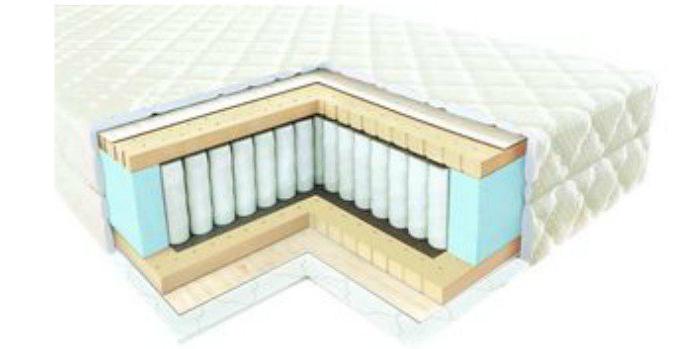
In order for air to move freely throughout the entire volume of the mattress, many models have ventilation holes.
When purchasing products made from such materials, you need to ask for certificates of conformity.
Mattress base
A high-quality base for a mattress consists of a frame to which wooden slats are attached - elastic planks about 1 cm thick. In cheaper models it is made of plywood.
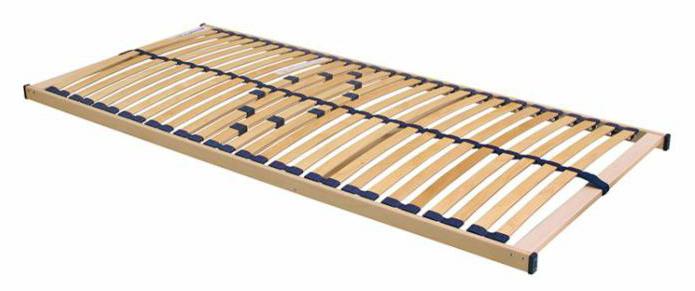
The slatted base is springy, making it more comfortable to sleep on the bed than on a hard surface (like plywood). Air flows better underneath it.
Still thinking about which one to choose? Consumer reviews advise trying to lie on it in trading floor. Therefore, you need to go there in clothes that are comfortable for this.
But lying on one model is clearly not enough to decide which mattresses are better. Customer reviews say that you need to try at least three models. Only then will you be able to choose the best one or look for more.
The mattress should not be too soft, because your spine will sag while you sleep on it, and in the morning your back and head will hurt.
Maybe you need to choose very hard mattresses? Customer reviews say that they do not get enough sleep on them and do not rest during the night.
You need to determine how long you will have to toss and turn on the mattress to become comfortable. A quality product does not require too many movements.
You need to pay attention to how much mattresses cost. Customer reviews suggest that the cheapest one worth buying should not be cheaper than 12 thousand rubles. Otherwise, you risk getting a thin product made from low-quality materials that will not be able to provide support to your spine.
A high-quality mattress will serve you for at least 10 years and will fully justify itself. A cheap one will soon become unusable, and you will need to spend money again.
Manufacturers
Which mattress is better to choose? Consumer reviews advise paying attention to the following manufacturers:
- Vegast is a Belarusian brand, one of the most popular. Produces mainly budget models. Many people like them. But there are reviews that the quality of the products does not match the price. The main complaints are that the mattress quickly loses its shape and all its characteristics.
- "Ascona" - Russian manufacturer. Engaged in production orthopedic mattresses. Consumer reviews indicate that company representatives are often negligent in their work, and products are defective.
- "Ormatek" - produces high-quality springless latex mattresses, cheaper than Askonov's. In addition to products of regular shape, it offers models for round beds.
- Atmosphere is an English manufacturer of expensive but high-quality orthopedic mattresses.
Where to buy
Modern people are making more and more purchases through online stores, and they also buy mattresses. Customer reviews say that it is fast and convenient. No need to spend a lot of time traveling to the shops. Sitting at home, you can choose the model you like, and even save money.

The only, but very significant, drawback may be that you will not be able to test it before purchasing. And what to do after your mattress turns out to be uncomfortable?
Such purchases may be justified if you already have a mattress from such a company, but you decide to purchase another one or have tested it with relatives or friends.
A competent choice of an orthopedic mattress is a reliable investment in your health and well-being for every day. But the abundance of products presented in stores only complicates the purchase, but does not make it easier. How to choose an orthopedic mattress and not waste your money?
In order to answer this question, we decided to prepare this extensive review for you. In it we will look at all the characteristics of orthopedic mattresses, talk about popular manufacturers, and talk about padding and hardness. After reading this material, you will receive all the necessary knowledge and will be able to go shopping.
Choosing the size of an orthopedic mattress
An excellent option would be to buy a mattress and a bed in the same store - this way you can most accurately select the products for each other.
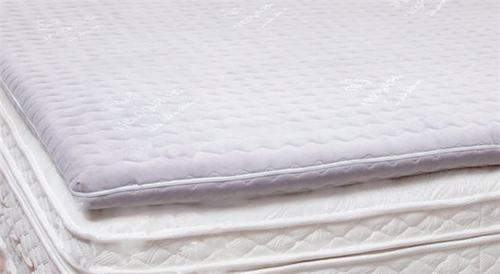
Mattresses thickness
Let's talk about the third characteristic - thickness. After all, the degree of comfort depends on the thickness of the mattress. The thinnest mattresses, 5-9 cm thick, are intended for small children under the age of three years. The maximum height should not exceed 10 cm. The child will be very comfortable and comfortable on such a mattress.
When a child turns seven years old, he should sleep on a mattress whose height is at least 11 cm. This is quite enough to ensure comfortable sleep and rest. Such a mattress will provide good support to the child’s spine, promoting its proper formation. The use of thinner mattresses at this age is unacceptable.

Mattresses for adults
An adult needs a more solid mattress, at least 15-16 cm thick. Most springless orthopedic mattresses can boast of this thickness. As for models with independent spring blocks, then their minimum thickness is 18 cm. The highest mattresses reach a height of 40 cm - These are elite models with multi-layer padding and increased comfort.. As for standard orthopedic mattresses, the most common models are from 15 to 25 cm thick.

We focus on weight
When choosing a mattress, you need to focus not only on age, but also on weight. People with overweight It is recommended to sleep on higher mattresses - this way they can feel more comfortable. As for people with low weight, they can choose inexpensive thin mattresses for themselves. This choice is due to the fact that the pressure on the surface of a thin person is quite small, so buying a thick mattress will be a waste of money.
The thinnest mattresses, only a few centimeters thick, cannot be called independent products - they are designed to level and improve other surfaces. For example, they can be used to level the surface of a sofa and make it more comfortable for sleeping.
Choosing the firmness of the mattress
The next parameter is mattress hardness. Our comfort and well-being depend on it. In most cases, thin mattresses only harm our health. They cannot provide normal support to the spine and create good conditions for a comfortable night's rest. The optimal choice would be medium-hard mattresses.
As for the hardest mattresses, then they are recommended for osteochondrosis and spinal hernia. They are made from dense fillers, such as coconut coir or reinforced polyurethane foam. The surface is hard and not entirely comfortable, but in the presence of spinal diseases, it provides reliable support for damaged and diseased areas.
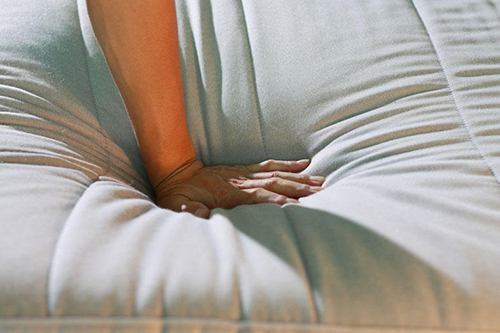
Low stiffness
There are five main gradations of hardness:
- Low;
- Below average;
- Average;
- Above average;
- High.
Low-hardness mattresses are made from natural latex, foam rubber or cotton wool. They are suitable for people with low weight or as a temporary sleeping surface. And while natural latex still has orthopedic properties, foam rubber and cotton wool do not have them - sleeping on foam rubber and cotton wool mattresses is not recommended for healthy people of average weight.

Medium hardness
Medium-hard mattresses are made from composite padding, polyurethane foam, artificial latex, struttofiber and many other materials. Such mattresses have pronounced orthopedic properties and are in great demand. Mattresses with independent spring blocks fall into the same category (however, they can have different hardness).

High rigidity
High-firm mattresses are made from coconut fiber and other hard fillings, such as struttofiber and composite materials. Most often they are positioned as medicinal, but nothing prevents healthy people from sleeping on hard mattresses. The exception is people over 50 years of age - they are not recommended to sleep on hard surfaces.
As for other rigidity criteria, they are intermediate. You can check the hardness of a mattress in its passport data - the maximum weight that the selected mattress can withstand is also indicated here. By the way, the choice depends on a person’s weight - thin people can sleep on soft surfaces, while overweight people are advised to purchase a firmer model.
Spring orthopedic mattresses
Which mattress is better to choose - spring or springless? In order to answer this question, let's look at the differences between both varieties.
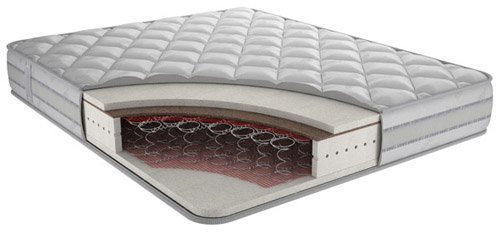
Classic spring mattresses
Spring mattresses are divided into two large categories - these are classic spring mattresses and mattresses with independent spring blocks. Classic models were born more than a hundred years ago. Inside them are springs connected to each other, providing support for the surface and the person sleeping on it. Such mattresses do not have any orthopedic properties., since the springs here are interconnected - when one spring bends, the surrounding ones bend too.
The lack of orthopedic properties leads to curvature and damage to the spine - remember this if you like to sleep on soft, springy mattresses.
To top it all off, spring mattresses have another important drawback - over time they begin to creak like hell. Springs constantly wear out and rub against each other. After several years of operation, the spring connection points begin to creak mercilessly. The creaking is so strong that it disturbs the sleep of other people in the room.
There are also some distinct advantages - the affordable cost of a spring mattress. The springs are quite cheap, there are no expensive packings inside, so the prices are very low. The list of advantages can be completed here, since there are almost none. Here are more detailed lists of advantages and disadvantages:
Advantages:
- Reliability – spring mattresses can easily withstand heavy loads and children’s games;
- Affordable price – these are the cheapest mattresses.
Flaws:
- Lack of orthopedic properties - frequent sleeping on such mattresses can cause discomfort and diseases of the spine;
- Dust accumulation – acting like bellows, spring mattresses accumulate a lot of dust, allergens and microorganisms inside;
- Creakiness – if the mattress begins to creak, this process cannot be stopped. At the same time, it will easily serve for another 15-20 years, tormenting everyone with its creaking.
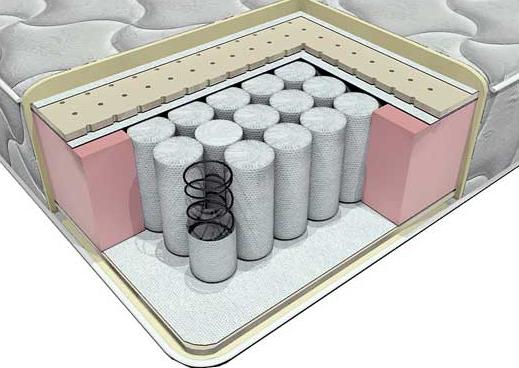
Mattresses with independent spring blocks
You can start choosing an orthopedic mattress by examining rather unusual models - these are mattresses with independent spring blocks. They have a simple but impeccable design. In them, each spring moves separately, in its own case, without touching other springs. On both sides there is additional padding made of some material. The result is a reliable and durable mattress with excellent orthopedic properties.
Good mattresses with independent springs have up to 200-300 springs per square meter. Thanks to this, these mattresses take the shape of the body of the person lying on top and provide decent support for the spine in almost any position. If we compress several spring blocks, the surrounding springs will remain uncompressed.
Mattresses with independent spring blocks are aimed at people of all ages. Their level of firmness varies at mid-points, so they are suitable for a wide range of people. Experts recommend them for use from 12 years of age. Independent springs do not creak, have a decent level of strength, and can withstand a fairly large weight of a sleeping person. Therefore, such mattresses are in good demand. Here is a list of their advantages and disadvantages:
Advantages
- The presence of orthopedic properties - you can sleep on such mattresses as much as you like without feeling discomfort. They support the back well and follow the shape of the body well, bending only where necessary;
- Reliability - of course, mattresses with independent springs are less durable than classic spring mattresses, but thanks to carefully selected spring material they can withstand even the crazy games of children;
- High level of comfort - orthopedic mattresses with independent spring blocks are very comfortable.
Flaws
- High cost - perhaps this is the only significant drawback of orthopedic mattresses with independent spring blocks.
We draw intermediate conclusions - mattresses with independent springs have pronounced orthopedic properties and are the best option when choosing a good mattress. But ahead of us there are also springless models with good characteristics.
Springless orthopedic mattresses
In order to choose the right orthopedic mattress, you need to carefully familiarize yourself with springless models. Depending on the padding material, they can be soft, hard, medium hard and many others. Their design is devoid of springs, so they are absolutely silent and highly durable. Let's look at them in more detail, and then move on to fillers.

Materials
Springless orthopedic mattresses are made from foam rubber, cotton wool, polyurethane foam, struttofiber, latex, sea grass, horsehair, coconut fiber and many other materials. We exclude the first two fillers, which are cotton wool and foam rubber, from the materials under consideration, since they do not have orthopedic properties. As for other paddings, they allow you to create excellent surfaces for sleeping.
The absence of springs makes these mattresses extremely durable. They are able to withstand heavy loads, children can play on them, you can even jump on them - the padding will not be damaged. The exception is mattresses made from coconut coir - its slabs can burst and crumble, especially if the manufacturer used needle-punched fiber.
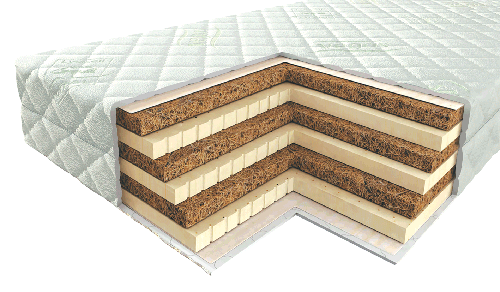
Single layer and multilayer
Springless orthopedic mattresses can be single-layer or multi-layer. Single-layer models are made from one material, for example, polyurethane foam. As for multi-layer models, there are several paddings at once, for example, latex, polyurethane foam and coconut coir. Thanks to this, manufacturers can create mattresses with different properties.
Springless mattresses can also be made from composite materials. A typical example is a mattress made of struttofiber, the fibers of which are woven with goat fur. As a result, we get an excellent mattress that retains heat well - suitable for lovers of warm mattresses. But the same structure, only with flax, allows you to create “cold mattresses” that practically do not heat up from human heat.

Memory Effect Materials
Some springless mattresses are made from Memory Foam material (memorix, memoryform, etc.). This padding has a foam structure, and thanks to its properties it precisely adapts to the human body, taking its shape. The padding does not exert any response pressure, since it can bend under the influence of human heat and load - the mattress takes on a shape that matches the pressure contour of the person lying on it. Having risen from the memory foam mattress, we can notice how it begins to restore its shape, spending a few minutes on this.
Springless Memory Foam mattresses create excellent conditions for comfortable rest. This is truly the latest development, but not everyone likes it, since if the air temperature in the room is too low, the padding material becomes very hard.

Now let's look at the general advantages and disadvantages of springless mattresses:
Advantages
- Long service life - there is nothing to break, so springless orthopedic mattresses last a very long time;
- Excellent orthopedic properties - mattresses provide good back support and follow the shape of the body;
- Wide range of hardness - springless mattresses can be soft and very hard.
Flaws
- High cost of individual models - some springless mattresses are indeed very expensive, as they are made from expensive materials (natural latex, coconut fiber, memory materials);
- Insufficient softness - some spring mattresses are much softer than their springless counterparts.
How to choose the right orthopedic mattress based on padding materials? You need to pay attention to the rigidity of the material and the comfort of the mattress itself - it would be nice if the store had the opportunity to test individual models.
Which filler do you prefer?
In order to choose the right orthopedic mattress for your bed, you need to understand the fillers. There are quite a lot of them, so in our review we will only touch on the most popular of them.
Mattresses filled with cotton wool, down or cheap foam should be avoided - despite their convenience, they lack orthopedic properties. In addition, cotton wool tends to form lumps.
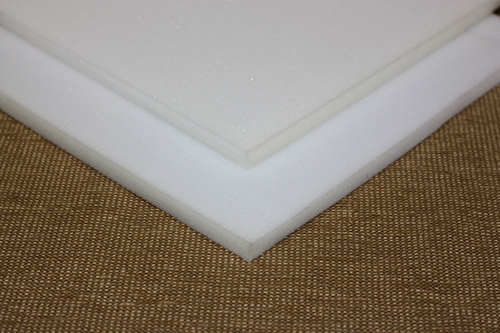
This material is the most common. In fact, this is the same foam rubber, only with increased level rigidity. Inexpensive orthopedic mattresses are made based on polyurethane foam with additives, which boast good characteristics. This material has a long service life, is able to withstand heavy loads, but is characterized by the presence of a number of critical shortcomings.
In addition, some experts consider polyurethane foam mattresses to be harmful. According to them, this material releases dangerous volatile components into the air. But this information is not considered reliable, so polyurethane foam still remains the most popular material for filling mattresses.
Advantages
- Cheapness - the most inexpensive mattresses are made on the basis of polyurethane foam, accessible to a wide variety of segments of the population;
- Withstands heavy loads - children can safely jump on polyurethane foam mattresses;
- Good orthopedic properties - mattresses made from this material are recommended for those who want to take care of their health.
Flaws
- Pronounced absorbent properties - since polyurethane foam is a porous material in its structure, it absorbs moisture too well. At the same time, it is very difficult to remove it;
- Difficult to clean – Due to the same absorbent properties, polyurethane foam mattresses are difficult to clean.

Natural latex is made from the sap of the Hevea plant, which is processed and foamed. As a result, a material with orthopedic properties is born. Latex supports the spine well and takes the shape of the body. Moreover, it can be soft or hard - the range of hardness is quite wide. This material does not cause allergies, it is able to easily get rid of moisture, and has endurance.
Latex mattresses have become widespread. Not only children, but also adults sleep on them. The porous structure of the material allows it to withstand heavy weight, and the use of additional materials makes it possible to significantly increase rigidity. By the way, artificial latex is more rigid than its natural counterpart, and cheaper.
Advantages
- Pronounced orthopedic properties - latex mattresses follow the shape of the body well and create comfortable conditions for sleeping. They are also recommended for people suffering various diseases spine;
- Wide range of hardness - from soft to semi-hard, for every taste;
- An excellent combination of softness and orthopedic properties - we can sleep on a soft, but at the same time safe for the spine base.
Flaws
- High cost - latex mattresses are really more expensive than their counterparts made from other materials;
- Fragility - this statement is true for artificial latex mattresses. Over time, this material dries out and becomes brittle.
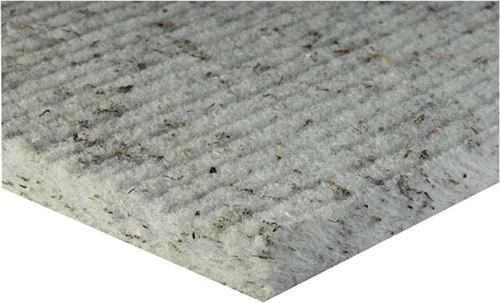
Behind the eerie name lies a material with excellent properties. Struttofiber has a decent level of elasticity, does not burn, is well ventilated, it is able to quickly get rid of moisture, and does not cause allergies. In addition, this material is not susceptible to deformation - it restores its shape almost instantly.
The structure of struttofiber is quite original - the fibers in this material are arranged vertically, which provides it with excellent properties. Additional fibers can be mixed with the main fibers - flax, horsehair, goat hair and much more. In addition, struttofiber is often combined with other fillers, for example, with blocks of independent springs or polyurethane foam.
Advantages
- Using struttofiber, you can create mattresses of almost any degree of hardness - from medium to high;
- Pronounced orthopedic properties - this material is actively used for the production of orthopedic mattresses;
- An increased level of strength and reliability – thanks to this, mattresses made from struttofiber have a long service life.
Flaws
- High cost of material - you need to pay good money for high quality.

Coconut fiber (coir)
Finally, let's talk about coconut fiber. This is a fairly rigid material, actively used for the production of orthopedic mattresses for children and adults. Coconut fiber does not rot, prevents the spread of bacteria, does not cause allergies, is well ventilated and does not retain moisture, has pronounced orthopedic properties.
Coconut mattresses are most often composite - in addition to coconut fiber, there are other fillers inside, for example, polyurethane foam or latex. The layers of padding alternate, resulting in mattresses with unsurpassed characteristics.
Advantages
- Excellent performance characteristics - coconut fiber does not rot when exposed to moisture and is not a source of allergens, is well ventilated, and provides proper back support;
- Pronounced orthopedic properties - the hard surface has medicinal properties and is recommended for many spinal diseases. Coconut mattresses are also used for sleeping children under three years old;
- High environmental friendliness - coconut fiber does not release any harmful components into the air.
Flaws
- The only significant disadvantage of coconut fiber is its high cost, which is associated with the complexity of producing the material.
Mattresses with coconut fiber are highly fragile, so when using them you need to be careful not to impact them.
Popular manufacturers of orthopedic mattresses
How to choose an orthopedic mattress for a bed, focusing on trademark? To do this, you will certainly need knowledge about the leading manufacturers of orthopedic mattresses.

This is one of newest companies, engaged in the production of orthopedic mattresses and bases. Production is carried out from environmentally friendly pure materials, and the properties of the paddings are studied in Comfort Line’s own laboratories. The warranty on all mattresses is 3 years. The product range includes both inexpensive mattresses and premium products.
Advantages
- Wide range of models - the company produces orthopedic mattresses for adults, mattress covers, as well as children's mattresses;
- There is a delivery service - purchased products are delivered to all major cities Russia.
Flaws
- Points of sale are not represented in all cities - no comments here.
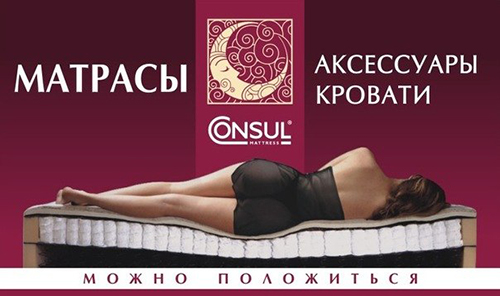
Consul holding has been operating in Russia for quite a long time. This is one of the leading manufacturers of orthopedic mattresses. The company's clients are not only ordinary people, but also music and film stars. Orthopedic Consul mattresses are made from environmentally friendly materials and undergo rigorous testing. All products are protected against bacteria with the help of probiotics.
The range of products produced is impressive - the Consul holding produces not only orthopedic mattresses, but also sleep accessories. The list also includes orthopedic bases and beds.
Advantages
- A very large selection of products - buyers can purchase not only mattresses, but also comfortable beds;
- Long-term warranty – this is additional recommendation to the selection of Consul mattresses;
- Delivery of mattresses throughout Russia - every resident of the country can become a client of the company;
- The use of innovative technologies in the production of mattresses - thanks to this, excellent performance properties of the finished products are achieved.
Flaws
- Low quality of service - this is evidenced by the analysis of user reviews posted on the Internet.

Askona company works on Russian market more than 25 years. Its range includes orthopedic mattresses, beds, pillows, bases, sofas, living rooms, wardrobes, sofas, additional sleep accessories and much more. Dozens of fillers are used to produce mattresses, and the careful design of each model allows you to experience the special comfort of sleeping on Ascona mattresses.
The brand is being promoted quite actively, so Askona mattresses can be purchased anywhere, including in the smallest Russian cities. If you don’t know which orthopedic mattress is best to choose for daily sleep, feel free to choose a mattress from this brand. By the way, in the company's stores you can lie on mattresses and evaluate their comfort.
Advantages
- Wide distribution of the brand - Askona mattresses can be purchased anywhere in Russia;
- Large selection of products - in addition to orthopedic mattresses, numerous sleep accessories are on sale;
- Excellent product quality - all orthopedic mattresses from this brand are tested in our own laboratories.
Flaws
- High prices for some orthopedic mattresses - if you want to sleep on good mattress, then you need to come to terms with it.
A notable advantage of this manufacturer is the presence in its assortment of special therapeutic mattresses aimed at people with various diseases of the spine.